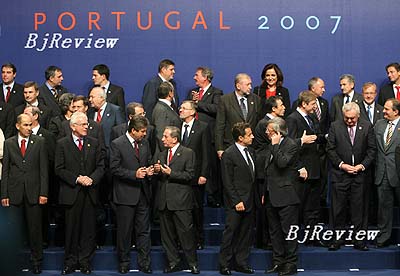|

Six years after the European Union (EU) deadlock over creating a constitution, the European integration process has received renewed impetus. On October 19, European leaders at an informal summit in Lisbon reached an agreement on the final text of a landmark treaty that laid the foundations for reforming the 27-nation union.
The treaty's framework was agreed upon in June at the end of a protracted summit in Brussels. The treaty was designed to replace the proposed European Constitution, which died after French and Dutch citizens voted it down two years ago. EU leaders will officially sign the treaty at their next summit in the Portuguese capital on December 13. After that, the Treaty of Lisbon will be open for national ratification. It is expected to enter into force on January 1, 2009, before the European Parliament elections that year.
"Although one single treaty is obviously not enough to solve the many problems currently confronting the EU, there is still no doubt that the treaty will have major implications for the European integration process," said Li Jingkun, a European affairs expert at the Institute of European Studies at the Chinese Academy of Social Sciences.
Li and other Chinese experts are cautiously optimistic about the future of the reform treaty. While hailing it as a major breakthrough, they point out that it is "a result of compromise" and will face a number of uncertainties.
Reinforcing cohesion
European Commission President Jose Manuel Barroso spoke highly of the reform treaty, calling it "the treaty of a large Europe." Speaking at a plenary session of the European Parliament several days after the Lisbon summit, Barroso said it was the first time in the history of European integration that states had negotiated together and reached an agreement on a common European treaty.
The treaty would reinforce the EU's cohesion in external affairs, Barroso said. He also said that the prosperity, freedom and security of Europe depended on the EU's capacity to "act decisively at the global level" and that with the reform treaty, Europe would have the conditions and the instruments to shape globalization. EU members must keep proving that they are not engaged in "institutional navel-gazing," he added.
European leaders reached a compromise on the reform treaty after rounds of talks, said Liu Jiansheng, an associate research fellow who specializes in EU studies at the China Institute of International Studies. "Given the many barriers, the EU has slowed down its expansion, lowered its long-term goal and switched to a more reasonable and pragmatic approach," he said.
Europe has traveled a long, winding path toward integration. In 1957, six European countries-Germany, France, Italy, the Netherlands, Belgium and Luxembourg- founded the European Economic Community with the Treaty of Rome, which was deemed as the beginning of the European integration process. The EU was formally established when the Maastricht Treaty came into force on November 1, 1993. The treaty was followed in 1997 by the Amsterdam Treaty, which increased the European parliament's powers, set up the start of a common foreign and security policy and made preparations for reforming EU institutions before further enlargement. Next came the Treaty of Nice in 2001-a further attempt to reform the union's institutional structure before adding new member countries.
In December 2001, the EU announced it would create a constitution to replace all previous treaties with a single document. Representatives of the union's 25 member states signed a constitutional treaty in Rome in 2004. But in May and June of 2005, citizens of France and the Netherlands vetoed it down in referendums, plunging the EU into an institutional crisis.
| 